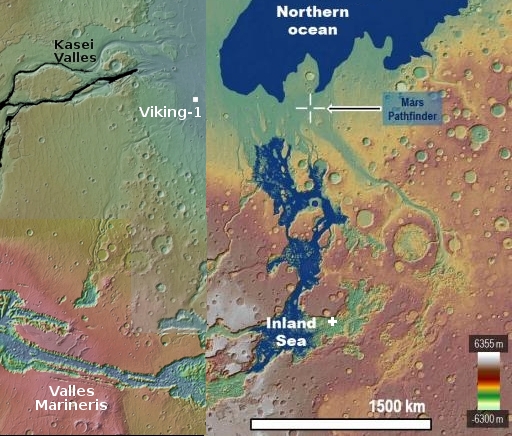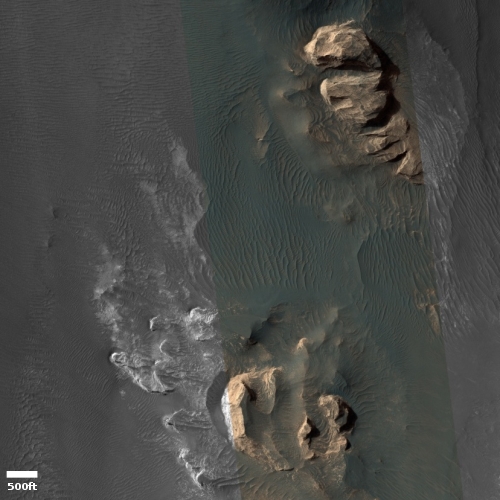Dusty chaos in Martian canyons
Cool image time! The photo to the right, cropped and reduced to post here, was taken on May 30, 2021 by the high resolution camera on Mars Reconnaissance Orbiter (MRO). It shows the dusty dry floor of the chaos region of rough terrain in a side canyon of Valles Marineris, near its outlet. The color strip and the bright outcrops suggest that this terrain contains interesting minerals and resources. To determine exactly what those materials are however requires more information not available in this photo.
This ancient chaos terrain is the leftover eroded sea floor of a intermittent inland sea, leftover water from the catastrophic floods that are theorized to have flowed out of Valles Marineris and carved its gigantic canyons.
The overview map below shows this hypothesized sea.

The map comes from figure 3 of the paper that proposed this inland sea. The white cross marks the location of today’s cool image. I have expanded the map to show more of Valles Mariners to the west, along with Kasei Valles to the north, with the black within that canyon indicating the extent of a past major lava flow.
Today’s image however shows neither water nor lava. It instead provides another example of Mars’ dry equatorial regions, located at 7 degrees south latitude. Much of the terrain here is covered with sand and dust forming rippling sand dunes of some beauty (this is even more evident in the full image).
Once there might have been a sea and water here. No more. As it slowly drained and evaporated away it left behind the chaos terrain of random knobs, mesas, and canyons that now cover this canyon floor.
What remained at the equator of Mars is the desert science fiction writers have imagined for the last century.
On Christmas Eve 1968 three Americans became the first humans to visit another world. What they did to celebrate was unexpected and profound, and will be remembered throughout all human history. Genesis: the Story of Apollo 8, Robert Zimmerman's classic history of humanity's first journey to another world, tells that story, and it is now available as both an ebook and an audiobook, both with a foreword by Valerie Anders and a new introduction by Robert Zimmerman.
The print edition can be purchased at Amazon or from any other book seller. If you want an autographed copy the price is $60 for the hardback and $45 for the paperback, plus $8 shipping for each. Go here for purchasing details. The ebook is available everywhere for $5.99 (before discount) at amazon, or direct from my ebook publisher, ebookit. If you buy it from ebookit you don't support the big tech companies and the author gets a bigger cut much sooner.
The audiobook is also available at all these vendors, and is also free with a 30-day trial membership to Audible.
"Not simply about one mission, [Genesis] is also the history of America's quest for the moon... Zimmerman has done a masterful job of tying disparate events together into a solid account of one of America's greatest human triumphs."--San Antonio Express-News
Cool image time! The photo to the right, cropped and reduced to post here, was taken on May 30, 2021 by the high resolution camera on Mars Reconnaissance Orbiter (MRO). It shows the dusty dry floor of the chaos region of rough terrain in a side canyon of Valles Marineris, near its outlet. The color strip and the bright outcrops suggest that this terrain contains interesting minerals and resources. To determine exactly what those materials are however requires more information not available in this photo.
This ancient chaos terrain is the leftover eroded sea floor of a intermittent inland sea, leftover water from the catastrophic floods that are theorized to have flowed out of Valles Marineris and carved its gigantic canyons.
The overview map below shows this hypothesized sea.

The map comes from figure 3 of the paper that proposed this inland sea. The white cross marks the location of today’s cool image. I have expanded the map to show more of Valles Mariners to the west, along with Kasei Valles to the north, with the black within that canyon indicating the extent of a past major lava flow.
Today’s image however shows neither water nor lava. It instead provides another example of Mars’ dry equatorial regions, located at 7 degrees south latitude. Much of the terrain here is covered with sand and dust forming rippling sand dunes of some beauty (this is even more evident in the full image).
Once there might have been a sea and water here. No more. As it slowly drained and evaporated away it left behind the chaos terrain of random knobs, mesas, and canyons that now cover this canyon floor.
What remained at the equator of Mars is the desert science fiction writers have imagined for the last century.
On Christmas Eve 1968 three Americans became the first humans to visit another world. What they did to celebrate was unexpected and profound, and will be remembered throughout all human history. Genesis: the Story of Apollo 8, Robert Zimmerman's classic history of humanity's first journey to another world, tells that story, and it is now available as both an ebook and an audiobook, both with a foreword by Valerie Anders and a new introduction by Robert Zimmerman.
The print edition can be purchased at Amazon or from any other book seller. If you want an autographed copy the price is $60 for the hardback and $45 for the paperback, plus $8 shipping for each. Go here for purchasing details. The ebook is available everywhere for $5.99 (before discount) at amazon, or direct from my ebook publisher, ebookit. If you buy it from ebookit you don't support the big tech companies and the author gets a bigger cut much sooner.
The audiobook is also available at all these vendors, and is also free with a 30-day trial membership to Audible.
"Not simply about one mission, [Genesis] is also the history of America's quest for the moon... Zimmerman has done a masterful job of tying disparate events together into a solid account of one of America's greatest human triumphs."--San Antonio Express-News



Here’s some food for thought!! Looking at all the resources that USED to be there, don’t you think that under all that waste and destruction they’ll eventually find evidence of a DEMOCRAT Headquarters??